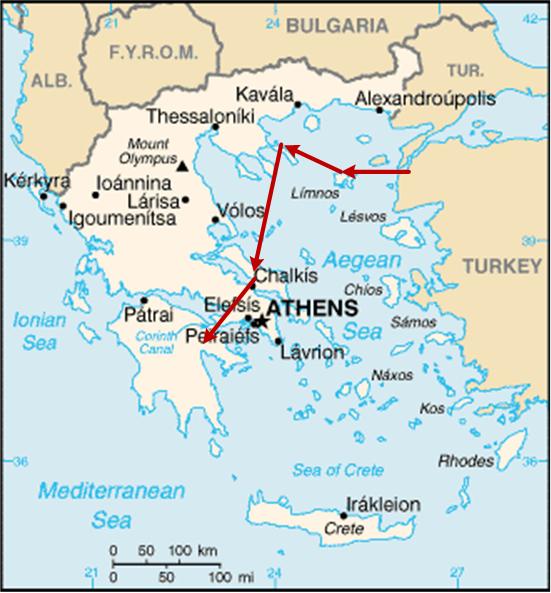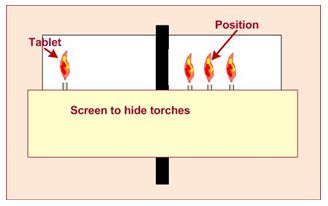- Messaging Archeology -->
- Back to Landing strip
The first recorded message
The very first transmitted message that appears in history needed to be pretty simple as it used the same on/off switch for both meaning and transmission protocol. Here it is.

In 1184 BCE , so the legend goes, the Greek Queen Clytaemnestra (which means praiseworthy wooing) was waiting in Mycenae for news of her husband Agamemnon(whose name translates to very resolute), who was fighting to capture troy. The message that he had succeeded was to be sent by lighting a series of fire beacons. It may never have happened, but the story was faithfully recorded by Aeschylus some six hundred years later and here is a translation of his poem.
From Ida's top Hephaestus, lord of fire, sent forth his sign; and on, and ever on, beacon to beacon sped the courier-flame. From Ida to the crag, that Hermes loves, of Lemnos; thence unto the steep sublime of Athos, throne of Zeus, the broad blaze flared. Thence, raised aloft to shoot across the sea, the moving light, rejoicing in its strength, sped from pyre of pine, and urged its way in golden glory, like some strange new sun, onward, and reached Macistus' watching heights. There, with no dull delay nor heedless sleep, the watcher sped the tidings on in turn, until the guard apon Messapius' peak saw the flame gleam on Euripus' tide, and from the high-piled heap of withered furze lit the new sign and bade the message on. Then the strong light, far-flown and yet undimmed, shot thro' the sky above Asopus' plain, bright as the moon, and on Cithaeron's crag aroused another watch of flying fire. And there the sentinels no whit disowned, but sent redoubled on, the heast of flame swift shot the light, above Gorgopis' bay, to Aegiplanctus' mount, and bade the peak fail not the onward ordinance of fire. And like a long beard streaming in the wind, full-fed with fuel, roared and rose the blaze, and onward flaring, gleamed above the cape, beneath which shimmers the Saronic bay, and thence leapt light unto Arachne's peak, the mountain watch that looks upon our town. Thence to th' Atreides' roof-in lineage fair, a bright posterity of Ida's fire. So sped from stage to stage, fulfilled in turn, flame after flame, along the course ordained, and lo! The last to speed upon its way sights the end first, and goes unto the goal. And Troy is taken, and by this sign my lord.
All that in just one flame, with the message and the protocol sharing the same flame. Beacon lit means both that there is a message and that the message content reads "Troy is taken." You may wonder if Clytaemnestra actually remembered what the message meant after Agamemnon had been away for ten years, or even if anyone was still bothering to look out for the message. Well she certainly had time to prepare to murder her husband when he arrived, so something must have got through.
As far as I can make out, assuming that Troy, if it existed, was where Heinrich Schliemann said it was, in northern Turkey, then this was the route that the message took, a distance of some 375 miles.

You can probably see the major flaw in this system. If you can't see a lit beacon, you don't know if Troy is still holding out or if you missed the message. But one bit messaging systems like this were used right up until the middle of the twentieth century.
The same idea of fire beacons was used to announce the arrival of the Spanish Armada off the coast of England in 1558. A chain of beacons was used that stretched from Cornwall to London, a distance of roughly three hundred miles. You can probably trace the route by plotting all the hills that are still called Beacon hill. For instance, there is a hill just outside Sidmouth in Devon, called Fire Beacon hill.
It is not just fire that can be used in this way. In 1939, at the start of World War Two, all the church bells in the U.K. were ordered to be silenced and only rung to warn of a German invasion. The protocol was a little more sophisticated than that used for previous beacon signals in that there had to be twenty five or more parachutists seen before the signal could be given.
On hearing the bells, the hordes of English yeomen that made up the Home Guard would rise from their fireplaces and fall with fury on their Hunnish foes. I can imagine the scene.
"Good lord Cedric, the bells are ringing."
"Oh I say Algenon, damned inconvenient of the Boche invading now. The cricket commentary is about to start on the Home service."
"What's your weapon of choice Cedric?"
"My old school cricket bat Algie. If it was good enough to dismay the Eton spin bowlers, it should certainly see off a few Hun."
"Good choice old boy. I thought I would take my meerschaum pipe. It generates a jolly good smoke screen."
"Excellent idea Algie. Oh, hello Gertie old stick; we are just girding our loins for war, don'tcha know."
"I have told you before Cedric I don't appreciate your dirty language in this house. Whatever you are up to, leave loins out of it."
"Sorry old bean, difficult to avoid the salty language of the Army at times like this. Well, toodle ooh old girl, we may not be back in time for tea."
Back in Greece however torch messaging had improved by leaps and bounds.
By about 150 BC, Cleoxenus and Democleitus had invented a torch telegraphy system, which was described by Polybius. The Greek alphabet was laid out onto five tablets, each of which had five positions. I have shown this below, using the English translations of Greek letters. There are some cases where a Greek letter translates into a character pair in English; TH CH PS and KS and there are only four positions in the last square.

You now need two large boards, each of which has five brackets to hold torches, a thick pole to separate the message boards and another large board below the message boards so that lit torches can appear and disappear. To view the messages at a distance you need two long tubes set next to each other and arranged so that one tube only sees the left hand message board and the other only sees the right hand board.

The message protocol is that torches on the left of centre show which tablet to consult, torches on the right the position on the tablet of the letter being transmitted. The transmission protocol is that someone wishing to send a message will first raise two torches and the receiver will reply by raising two torches, then the message can be sent. I haven't yet found any reference yet as to how an end of message was indicated.
Polybius also points out that you can agree beforehand to shuffle pages and positions around to achieve encryption. Clearly the need to prevent Google from reading your torchmails goes back a long way.
A wet alternative
Whilst fire signalling was the preferred option in ancient Greece because it had the potential to transmit any combination of Greek letters, Polybius also describes a water jar signalling system. For this you need to agree on the meaning of a number of phrases, like "enemy sighted", "cavalry to advance", etc., and each of these are given a number. Now mark the numbers in a line on two thin sticks.
Now you have to make two jars exactly the same size and shape, about two cubits by one cubit should do, and drill a hole near the base of each jar, into which you fit a cork. Now take two other corks a bit smaller than the hole in the top of the jars, you did leave the top open didn't you? Pierce the corks with your numbered thin sticks, fill the jars with water and drop the corks in so that the sticks poke out of the top. Now make sure that water pours out of the jars at the same rate. O.K. you are ready to start signalling.
Dismantle one of the jars, move it about 10 leagues away, fill it with water again and float your stick. To send a signal you first raise a flaming torch, did you remember to keep a flaming torch from the previous signalling system? When the other person sees your torch he raises a torch as well. O.K., listen carefully, the next bit is tricky. Lower your torch smartly and open the bottom hole in your jar, letting water out until the number of the message you want to send is just level with the top of the jar. Now raise your flaming torch again and relax, job done. The trick is that the other person has to follow your moves in exactly the same time. When he sees your torch disappear, he opens his jar and when your torch re-appears, he smartly bangs the cork in, reads off the number showing at the rim of his jar and looks the message up in his numbered list.
How many messages can you write on a head
One of the silliest ancient Greek ideas for long distance messaging was used by Histiaeus who lived in the fifth century BCE. I won't bore you with the whole story, but when Histiaeus wanted to send a message from Persia to Greece without the Persians knowing, he shaved the hair off of his favorite slave and tattooed the message on his head. He then waited for the hair to grow and sent the slave on his way with instructions to get the message recipient to shave his heaad again.
It is not recorded how long they had to wait for the hair to grow, or whether they used any hair growth treatments.
Last updated 05 November 2010